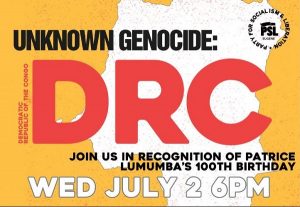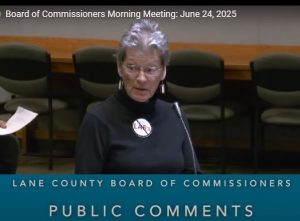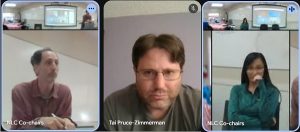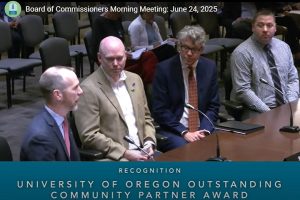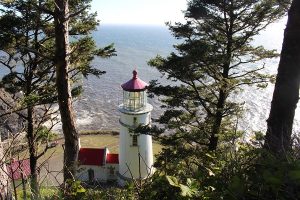LTD: What do our communities need us to be?
7 min read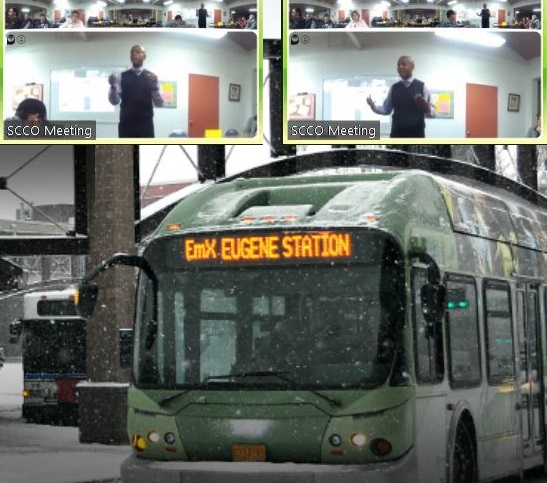
The new leader for LTD tells the Santa Clara Community Organization: EmX may not be the right mode for some areas. At SCCO on March 2, LTD’s Jameson Auten.
[00:00:10] Jameson Auten: My name’s Jameson Auten and I’m the general manager / CEO of the Lane Transit District, and I wanted to just introduce myself. I know that there have been concerns about some projects that are in this area. And I want to acknowledge that I’ve heard some of the issues and some of the conversation. I wanted you to know that.
[00:00:30] LTD is going onto a whole ‘nother path, as most transit systems in the nation are. The space in public transit is changing. It started changing years back as technology and new service models began to emerge, as public transportation began to see that it’s not on an island, that ridership matters, but outcomes matter more.
[00:00:52] And how do we get to those outcomes? How do we help people get to jobs? How do we help people get to schools? How do we help people connect to activities like the one we’re having right now?
[00:01:02] So we’re going to be looking at: What do our communities value? What matters to the citizens in this part of town? What matters to folks in our service area over in Coburg or in Cottage Grove? What does service look like in Cottage Grove versus running along Franklin by the university? These are all important questions that we’re going to start to answer.
[00:01:22] We recently kicked off a community assessment on how we do outreach, how we bring in data, turn that into information for decision-making, and then how we report back on how projects have gone to the community. So, transparency.
[00:01:37] We’re going to be doing that along with a steering group that is not LTD employees. We’re going to have an external steering group lead that, and we’re going to have LTD employees serve as a resource for that effort so that we can look at what best practices outreach actually looks like, if there is such a thing, and if there is, have it right here in the Eugene – Springfield area. So that’s what we’re going to do.
[00:02:01] And then from there, we’re going to look at a business case of: What do our communities need us to be? And that’s an important question. What do our communities need us to be? Not what does Jameson Auten need LTD to be? LTD is your tool. LTD is a tool and many tools in the box, and we’re going to define what that is and come back with a range of options and engage the community as we go through all our different analysis processes, using what we learned through our evaluation and how we communicate with each of you. So that’s where we are.
[00:02:34] The things that I’m telling you tonight are the things we’re going to deliver on. We’re going to deliver on a level of accountability, a level of outreach, and a level of engagement that I’m not sure you may have seen in the past, okay? We are going to do that.
[00:02:52] …The fact remains though that capital projects take a long time to do, right? Capital projects take a long time to do, so there’s a long tail, from start to finish. We’re going to look to see how we engage throughout the process where it’s a capital project or a service delivery model or something else.
[00:03:10] John Q: A comment and a question from a Santa Clara Community member.
[00:03:13] Santa Clara community member: I am concerned about this plan to take the EmX out this far, or at least the Santa Clara station, and I’ve read all the information that you’ve provided. I don’t see any common sense of what it achieved because the ridership isn’t even going to increase, even on your projections, and in the past projects they haven’t, while we’re going to give up a lane of traffic that is dearly needed for the number of people that are in this area.
[00:03:43] I ride the bus and I enjoy it. I’ve never seen more than 10 people on the bus between, I’m the northern part of the route of 51, and I can go all the way downtown in 30 minutes. When you make the switch, I won’t be able to do that anymore. So for me, it’s not even convenient, but I don’t know who’s really looking at the logistics of a project that was started.
[00:04:06] This tail you talked about. It’s like, is the tail wagging the dog now? I mean, you say you’re looking for public outreach, but I don’t know how it’s going to really fit into any of the planning or unplanning of things that maybe we don’t really need. In other words, I know that it’s good to provide public transportation, I agree, but that bus isn’t even getting used.
[00:04:30] And so you’re going to switch our, we have energy-efficient buses that come out here, and then it’s going to become diesel buses. And so I just don’t see how any of what I read in the report, how any of that is something that a community needs.
[00:04:49] Somebody planned it, but I don’t know what was driving it. So I’m hoping you could answer some of that or tell us how we can be involved if you want public outreach. Are you going to include it in any of the decision-making?
[00:05:07] Jameson Auten (LTD CEO): Yeah. So the answer to that last part is ‘Yes,’ is ‘Absolutely yes.’
[00:05:12] In terms of what you mentioned with EmX: Okay, now I want you to hear me clearly. I was just in Waikiki with my wife, and downtown Honolulu is very busy, right? It’s very busy. They have 60-foot articulated buses there. If you go to downtown San Francisco, you see 60-foot articulated buses. If you go to downtown Philadelphia, you see 60-foot articulated buses.
[00:05:40] You see 60-foot articulated buses running here along Pioneer Parkway in Springfield as well, right? Which environment is different from the other three, right? Springfield is, right.
[00:05:51] So I think the question really is, to the point of what you’re saying: What is the mode that makes sense and what is the preferred mode for the community? That’s the question that we’re going to answer.
[00:06:04] The project with the EmX coming here, that study on the environmental, when you do the environmental impact study, you put what I call the most intrusive set of capital that you’re going to put on there. And you measure that and you can always scale it back.
[00:06:20] So, even if there was a plan to put 15 EmX buses running per hour, right, every four minutes, you could scale back if that wasn’t the plan. ‘Cause you want to see what the most impact to the environment is going to be. So there is plenty of time for decision-making. There’s plenty of time.
[00:06:39] The process that we’re going through, that just kicked off right now, is using world-class people to help us determine what that process is for the communication. So that’s what we’re investing in right now, what that model looks like, so we don’t repeat what you just saw. That’s what we’re after.
[00:06:57] In the meantime, we’ll be doing the analysis of our services, both our fixed-route bus network and our Paratransit-on-Demand network, to see how that’s working and what needs to be changed there. So as we develop that plan, we’ll probably reach out to (SCCO Chair) Kate (Perle) and ask if we can have someone on that steering committee itself to help us lay out that plan. And then we’ll bring it back to you along the way, for sure, before it’s fully baked.
[00:07:23] John Q: A follow-up question about providing feedback on the EmX.
[00:07:27] Santa Clara community member: Quick follow-up on that: If you can help us just kind of delineate a couple things here, LTD… This project is not a city project. It’s not a county project. It’s not state project. It’s an LTD project. It’s what LTD does. So our communications would go to you, your staff, and the board… the communications should go to your shop, is that correct?
[00:07:50] Jameson Auten: It’s a partnership. So there’s components that are the city’s. We don’t own the infrastructure, we drive on the infrastructure. Same thing with the project in Franklin Boulevard with the roundabouts. We don’t own the infrastructure, we drive on the infrastructure.
[00:08:02] It really is a joint process. I think that’s part of some of the confusion, some part of some of the clarity that needs to be ironed out. So we’ll look at that as well, but I wanted to make sure that we’re clear on that.
[00:08:12] Santa Clara community member: Yeah. It is a partnership, and I thank you. The frustration is, ‘Who’s the lead?’ To be able to say: ‘We have these concerns.’ Everybody’s partners in this, but you’re going to be the lead. So that’s where you want to have this communication really come down to and—
[00:08:24] Jameson Auten: Correct. Correct. At the end of the day, we want to make sure that people know where to go, like what you’re saying: People know where to go, whether it’s us or the city. What’s easier for folks using the service or folks impacted by the service? Thank you for that.
[00:08:40] John Q: CEO Jameson Auten says 60-foot articulated buses may not be the right mode for Springfield. He promises world-class outreach to learn what the community prefers, and what makes sense.
